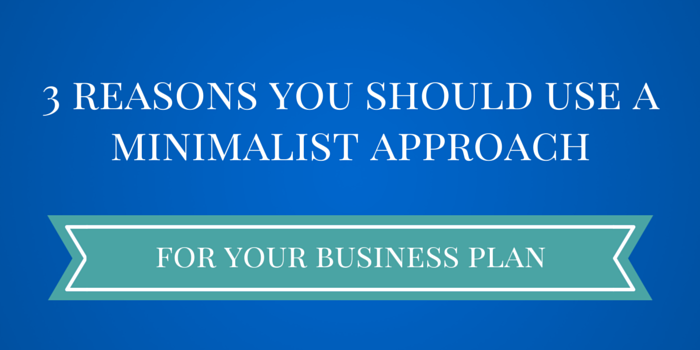Planning your business is important. Actually, it’s critical. Yogi Berra once said, "If you don’t know where you are going, you’ll end up someplace else."
To avoid ending up somewhere else, you’ve got to plan for success when starting your business. The interesting thing is that contrary to popular belief, there are multiple ways you can plan your business.
But in this guide we’re going to talk about how to write a business plan in the most simple and highly effective options we recommend you look into.
Depending on your creative style and what type of planning works best for you, you’ll have to decide which option is best for you. Every entrepreneur is different and we understand that.
By choosing the type of planning that suites you best, you’re more likely to stick to it and be more committed to the process.
The goal isn’t to write a mind-boggling 47 page business plan today.
The goal is to plan your business in a simple and effective way so that you’re able to pivot if necessary. To map out your thoughts and to understand your options. To figure out where your strengths are so that you can optimize them.
You need a course of action that is:
- Easy to fill out.
- Easy to execute.
- Easy to update and pivot with.
- Short, clear, and concise about your course of action.
Recommended: Business planning software can help you write a professional business plan that will lead you to success.
First, we will dive in and build a one-page business plan that outlines the 10 the core fundamentals that every business owner needs to understand about their business in order for it to be a success.
![]() After that, we'll introduce you to the resource we trust to help you execute on your new found knowledge and take your business plan to new heights. LivePlan, business planning software that has helped over 400,000 people like you get absolute clarity with a traditional business plan. One of those 400,000 was Ryan, the founder of Startup Savant.
After that, we'll introduce you to the resource we trust to help you execute on your new found knowledge and take your business plan to new heights. LivePlan, business planning software that has helped over 400,000 people like you get absolute clarity with a traditional business plan. One of those 400,000 was Ryan, the founder of Startup Savant.
Once you see LivePlan's video tutorials with expert advice, business plan examples from your specific industry, and a simple layout that makes up it's dashboard - you'll be just as excited about the planning process as we are.
Exclusive Bonus: If you'd like to try LivePlan yourself, here's an exclusive 50% off LivePlan promo code offered to our readers. You'll have 60 days of risk free planning with their 100% money back guarantee. Enjoy!
The goal of this guide
What we really want to do here is create a one-page business plan that is clear, concise and covers all the important aspects about your future business.
Depending on your business and industry, this one-page plan will be more than enough to get your thoughts in order.
Basically right now, the shorter the better. Out of most of the business plans we have seen, the short ones have been by far the most effective for the entrepreneur. It isn’t drawn out with unnecessary detail and changes can be made within minutes.
Think you can do that with a 47+ page business plan? Think again!
Right now just know that a one-page business plan will most likely be perfect for you and that’s exactly what we’re going to dive into first. The most critical points of interest in your business and that real action steps you’re going to take in order to build it into a success.

1) It has all the important information and is very clear
When you have a one-page business plan, you’ll be able to articulate the information that is most important to your business partner, investor, or anyone else who needs to have a better understanding of what you’re going to do as a business.
So instead of having all the critical aspects of your business be drowned out by the unimportant stuff in a massive business plan that puts people to sleep -- you’ll have a simple overview of the things that actually matter.
2) It helps you with your 30-60 second elevator pitch
Since it will be a very condensed version of what your business stands for, it will be incredibly easy for you to make a 30 to 60 second elevator pitch out of it.
This is important because if you’re trying to get an investment, new partner, or any kind of help from outside sources, you’ll be able to quickly explain the necessary details.
3) It is incredibly easy to pivot and update
When you’re starting a business, it can be hard to understand that you will likely have to pivot a number of times within the first year.
Locations change. Financing sources don’t pan out. And sometimes your customers want something a little different than you thought they did.
Unexpected things just happen. That’s the life of a business owner and is nothing to be scared of.
So if you have a 47+ page business plan, can you imagine how much of a nightmare it would be to have to go back and update it time after time? Exactly. Let’s try to make this as simple as possible.

Occasion 1) Funding from a bank, investor, or financial institution
If you're trying to get money from an investor, bank, or financial institution, you should probably be answering the questions that they are asking you. It is very possible that they'll have a special business plan template for you to fill out. This is normal, so don't freak out!
But before you go in and ask for anything, you'll need to have every question answered that they might ask you. This will be done by filling out a traditional business plan.
To help you with that process, we've listed the top 2 resources at the very bottom of this guide to introduce you to the solutions that make the planning process significantly easier. This way you won’t be wasting your time and will be fully prepared for any additional questions they may throw at you.
2) Government grants
Government grants will also often require you to fill out special templates of exactly what they are looking for. So you’ll need to answer their questions to get the money that they are offering.
In this situation your one-page business plan will make a wonderful cover page and having a traditional business plan filled out is also highly recommended.
It may sound like a lot of work, but considering that 8 out of 10 entrepreneurs fail within the first 18 months (statistics according to Bloomberg), careful planning at the beginning is highly recommended.
Need a traditional business plan to raise money and make a great first impression, but don't know where to start? We highly recommend using LivePlan, a business planning software that gets you funding ready by walking you through the process step-by-step. Plan your business risk and worry free with your 50% off discount. If you're not crazy about LivePlan after 60 days, they'll give you a full refund. No questions asked.

Now let’s dive into the 10 key questions you need to ask yourself. Do the work on this. If you don’t you’ll be going in blind. If you haven't already, download your very own worksheet to go along with this guide.
1) Is there an opportunity?
The first thing you need to understand and be able to articulate is the opportunity.
This could be why you came up with the business idea and why it is obvious that there is a need in the marketplace.
It could be why there is a gap in the market and how you can fill it. Maybe a pain point that your customers are having and how you can solve it.
If you can keep it to one sentence with your opportunity statement, that will be perfect. It should be clear and convincing enough to where the reader of your business plan will want to jump out of their seat and invest immediately.
Ok maybe not literally, but they should absolutely understand the opportunity and why you’re going to pursue is. Otherwise, why bother in the first place?
2) What is your solution?
Now that you understand and are able to point out the opportunity of your business, how are you going to solve that problem?
What is your business going to do that will solve your customers pain or bring them pleasure?
Again, being able to explain your solution in one sentence should be your top priority right now.
After you nail down your one sentence answer to ‘what is your solution?’, you can go into a little more detail about how you plan to solve that problem your customers are having. Try explaining it in 3-4 sentences.
You can even think of this section like a book headline. The first part is the eye catching and very clear statement on what the book is about. And then the actual book text talks in more detail about the ‘bread and butter’ of the story.
3) Who is your target customer?
After you see the pain your customer is having and the solution that will solve it, you will need to figure out who your target market is.
The bigger question you need to answer is, who are you selling to? Are they people inside the mall who will want to grab a snack as they walk through the mall?
Are they businesses? Or both? Keep in mind that you might have two separate types of target customers.
For example, your business might be a mall concession stand and serve coffee to people passing by. So the two customers you would be serving are the initial customer who is actually buying the coffee and the supplier of that coffee.
You could make a special deal with them by buying coffee in bulk. So at the end of the day, you get a better deal on coffee to sell and they get a guaranteed revenue stream. Everybody wins.
Your target market will include your end customer (person buying the coffee), but also strategic partnerships (the coffee supplier).
The better of an understanding you have on this part of your business, the more likely you’ll be to impress potential partners, investors, and anyone else who is looking for more information about your business.
4) Who is your competition?
Now we need to take a look around the marketplace and figure out who your competitions are.
Is there a business in your area that offers a similar product or service to what you’re looking to offer?
How long have they been around? Do they have a loyal customer base? Are you competing for the same customers?
Is their product or service better than what you’re offering while at the same price point?
These are all questions you need to answer for yourself. Be sure to jot down the top 3-5 competitors you have, because you’re going to need that info for the next question we’re about to ask you!
5) How is your business different than your competition?
Careful not to copycat! That is a surefire way to corner yourself into some serious trouble. Now that we know who your competition is, you’ll need to find out how you’re different.
If your customers, partners, investors can’t tell the difference between your business and that of your competitors, what’s the difference? They really don’t have any good reason to do business with you over your competition.
Here are a couple ways to can explain how you’re different:
- You have a social aspect embedded into the heart of your business.
- Your product or service is individually crafted for each customer.
- Your product or service is the most affordable on the market.
- Your product or service saves your customers time.
- Your product or service is easier to use than your competitors.
- Your product or service offers a faster solution.
- Your product or service is a more trusted brand.
Do any of these points resonate with you? If not, think hard about this one and be able to describe your differences in 2-3 sentences.
What you want to do here is compare yourself and the key things that outline how you're more qualified to serve your customer.
Yes, write down now how you’re different than your competitors on your one-page business plan template beside you. You won’t regret it!
6) Who are your team players?
Starting a business is hard. There’s no question about it. But something to keep in mind is that having help can be a massive weight off your shoulders.
The team players are the key people that are going to make your business work. They are the employees, partners, mentors, family, or anyone else who will help you along your journey.
The sooner you realize who you can count on to start, run, and grow your business -- the better. As an added note, it’s a very wise move to find a mentor. It might even save your new business from demise.
7) What is your mission?
Now let’s talk about your mission. The thing that your business stands for today and will stand for in 100 years.
Your mission could be to provide the warmest clothes for babies on the market. It could be to provide a private classroom for entrepreneurs everywhere to learn how to start a business at their own pace.
For instance the mission for Startup Savant is to simplify entrepreneurship and make the world a better place by giving back at the same time. Your mission is what drives you everyday to add value to your customers lives and make it easier on them for buying from your business.
So write it down. What do you stand for?
8) How will you market your business?
Marketing can be one of the most difficult and intimidating aspects of being a business owner. Everyone struggles with it (or at least has in the past).
Some of the most popular methods to marketing your businesses include:
- Banners and flyers around your local area.
- Asking for referrals from previous customers.
- Social media marketing.
- Content marketing.
- Pay Per Click advertising. (Google Adwords)
To start off, you should just try two or three of the above methods. If you take on too many methods to marketing your business in the beginning, you’ll just get overwhelmed and burn out.
"If you chase two rabbits, you will not catch either one." - Russian Proverb
You could use Facebook as a credibility platform and have customers ‘like’ your page for a special offer. And as your page ‘likes’ and credibility grow, you can have special offers or updates on your page to get that second purchase from the same customers.
This way in the future when people check out your Facebook page, they’ll see a flood of satisfied customers and evidence of your knowledge as a product or service provider. In other words, you're building some serious trust!
You can also use a tool like Google Adwords to send targeted visitors to a landing page and ask them to sign up for your email list. From there, you can send those subscribers emails and build their trust over time. Then, when you’re ready, you can offer them a special offer and ask for the sale.
9) What is your projected revenue?
Money. Let's talk money.
One of the other biggest things you need to keep in mind is how much money your business plans to make. In other words, what are your projected sales?
You will need to answer this question on a quarterly and annual basis so you have a firm understanding on what is actually possible. This is very important because you don't want to expand too quick and run out of money. Hiring employees and not having enough money coming in to pay them is not a good thing.
You don't have to get into all the fine details that you would on a longer, more thought out business plan. Right now you should just make sure you have a clear understanding of what is possible and to set specific goals for yourself.
In your one-page business plan template, we'll give you an outline for your projections. Just fill in the blank!
Big tip: Be realistic. Everyone wants to make $5 million dollars in their first year, but rarely does that ever happen. So be honest and don't put that kind of pressure on yourself. You're starting this business to be sustainable and an income source for years to come, so there's no need to get impatient.
10) What are your goals for your business?
Last but not least, you need to think about the top three things you’d like to accomplish in the short term and the top three things you’d like to accomplish in the long term.
For example, how many customers would you like your business to have served within the next year? Is that amount possible? Now answer that same question for 10 years from now. 20?
Other than customers being served per year, what are the top three things that you are going to get done in the short-term and long-term?
Write each of these things down in your template for this guide. Like Yogi Berra said, “If you don’t know where you are going, you’ll end up someplace else.”

Now that we’ve covered the 10 ‘make-or-break’ questions to planning your business and built a one-page business plan, we’re going to actually build a formal business plan to make everything official.
At Startup Savant, we’re huge fans to using tools and resources that make your life significantly easier when possible. That’s why we’re going to introduce you to the 2 tools you need to look into to plan your business even more extensively and start working towards owning your future.
Option 1) LivePlan Business Planning Software
 By far one the coolest tools available to entrepreneurs who want to plan their business is LivePlan (exclusive 50% off discount). We have reviewed LivePlan in the past, and have stuck by our recommending them since the day Startup Savant were born.
By far one the coolest tools available to entrepreneurs who want to plan their business is LivePlan (exclusive 50% off discount). We have reviewed LivePlan in the past, and have stuck by our recommending them since the day Startup Savant were born.
With it’s expert advice in the form of examples and on page videos, you can create a flawless business plan within minutes.
Everything is set up to make the process as simple as possible for you, just like we did in this guide. They also have a 60 day money back guarantee, so if you don’t see the value in it like we do, you can get a 100% refund. No questions asked.
A look inside LivePlan


Wrapping up & writing a solid plan
Having a thorough plan from the beginning can make or break your business. That's why you've got to do it right the first time and understand all the moving parts of your business now.
When you have a firm grip on the strategy behind your business, you'll be able to control it every  step of the way and make changes when necessary.
step of the way and make changes when necessary.
Please also note that the links for LivePlan are affiliate links and we will receive a small commission at no additional cost to you if you decide to plan your business with them.
At that same time, as part of our mission to make the world a better place, we’ll donate a percentage of all our revenue to classrooms in need through DonorsChoose.org. So far we have helped over 36,000 students get a more enriching education and we have no plans to slow down!



